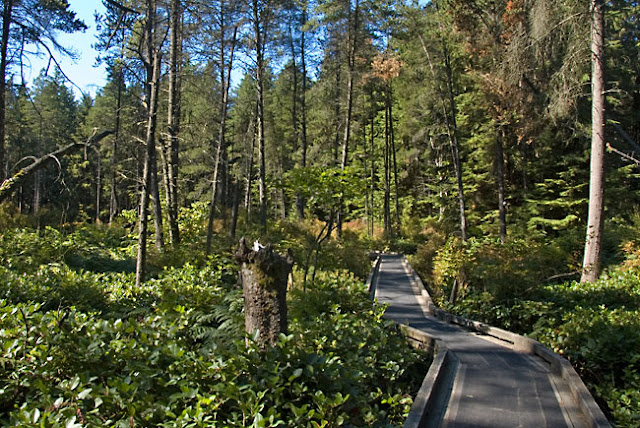the Camosun Bog

Vancouver, B.C. was covered in ice 12,000 years ago, two millenniums later, the ice then receded which left a scarred landscape. The landscape became a lake, surrounded with sedges and cattails. After several millenniums later, the lake then became a swamp, the swamp's dead plants blocked the sources of fresh water and sediment. As the plants decayed, they used up all the available oxygen, then 2,000 years ago, the swamp met the conditions perfectly for a bog.
The picture in the left is the keystone species of the Camosun bog, the sphagnum moss. Without the species, the bog would not be able to exist to this day. Its incredible ability to absorb water and pump out hydrogen ions into the surroundings make the environment very acidic. The species is a Bryophyte, which a cuticle, xylem, and phloem. Like its close relative, the seaweed, its sperm also swim, thus requiring constant source of water for sexual reproduction. When sphagnum moss dies, it is called a peat. Peats decay very slowly, which helps the top layer of a living sphagnum grow by conducting water. New sphagnum grows on top of a peat, therefore a bog is like a layered cake, taking millenniums for it to "bake". Peat and soil are alike, but the two have very different texture. Peat is light, spongy, and can crumble to tiny splinters, unlike soil which is heavy and rough. Digging through the Camosun bog is like digging through time, each metre below surface represent 400 years. Although occasionally human bodies are found in bogs due to the acidic peat, there hasn't been any human bodies found in the Camosun bog, except for artifacts, like a hockey puck from the 1940s.
An old lady was interviewed during a tour around the bog, she used to play as a goalie when she and her guy friends played hockey at the Camosun bog during her childhood. She noticed that the lake used to be bigger and had extended to the boardwalk areas, and that there was also a flat are where she and her friends could play hockey. She also commented that during her childhood, the trees were "quite short" only ranging from nine to eleven feet tall. Huckleberries used to grow around the area of the bog.
The Camosun bog, and all other bogs, they are carbon sinks due to the slow rate of decay. Carbon sinks are important since they help prevent global warming. Bog convert carbon dioxide to peat, which the preserved peat do not release unless it has decayed for a thousand years, or sometimes even more.
The Camosun bog is traditional territory of the Musqueam people, the bog region has been shown to have been used by the Indigenous people from 4,000 years ago. In the blog, camosunblog, regarding the Camosun bog they stated that, “the bog is a source of story, tradition, and medicine for the Musqueam”, which is why it is important to the Musqueam people.
Back in 1929, the Camosun bog was almost destroyed due to the development of city. Drains were installed which reduced water levels, destroying the moss and preventing them from sexual reproduction. The influx of nutrients cause the native bog plants to be outcompeted by invasive plants (plants that are native to B.C. but invasive to bog plant species). A hemlock forest (invasive to bog) grew where a stable bog had existed for over 2,000 years, it rooted in peat, which then made the hemlock trees to easily fall over during a windstorm.


 The pictures around this text, are pictures of the native bog plants, such as, Sundews, Cloudberry, Labrador tea, Bog laurel, Bog cranberry, and Pine trees. Each and every one of the species help each other thrive in the bog.
The pictures around this text, are pictures of the native bog plants, such as, Sundews, Cloudberry, Labrador tea, Bog laurel, Bog cranberry, and Pine trees. Each and every one of the species help each other thrive in the bog.First photo - https://www.allnationsstampandcoin.com/newsletters/news149.html
Second photo - https://www.123rf.com/photo_62247462_green-peat-moss-or-sphagnum-moss.html
Third photo - https://joiedusoleil.wordpress.com/2013/05/21/camosun-bog/
Last five photos - camosunbog.ca/species/






Comments
Post a Comment